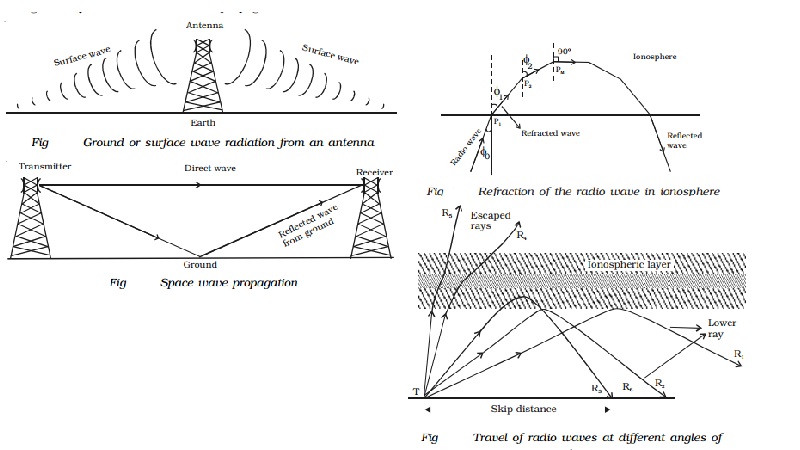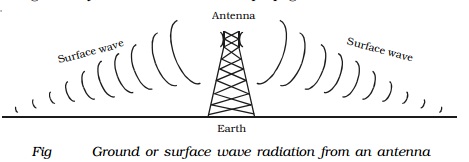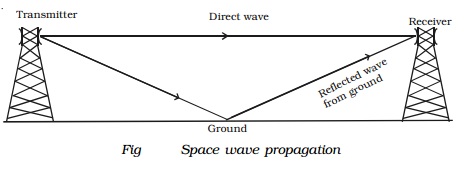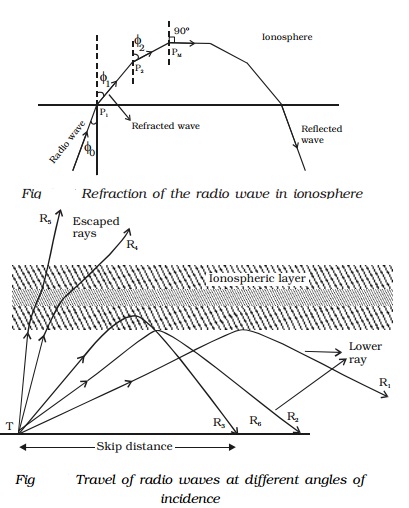Chapter: 11th 12th std standard Class Physics sciense Higher secondary school College Notes
Propagation of electromagnetic waves

Propagation
of electromagnetic waves
The propagation of electromagnetic
waves depend on the properties of the waves and the environment. Radio waves
ordinarily travel in straight lines except where the earth and its atmosphere
alter their path. The useful ranges of the electromagnetic spectrum for
communication are summarised in Table 10.1.
Radio wave is propagated from the
transmitting to the receiving antenna mainly in three different ways depending
on the frequency of the wave. They are :
1.
Ground (surface) wave propagation
2.
Space wave propagation
3.
Sky wave (or) ionospheric
propagation
Ranges of electromagnetic spectrum used for communication (NOT FOR
EXAMINATION)
Name Frequency Wavelength
Extremely
Low Frequencies (ELF) 30-300 Hz 107 - 106 m
Voice
Frequencies (VF) 300-3000 Hz 106 - 105 m
Very
Low Frequencies (VLF) 3-30 kHz 105 - 104 m
Low
Frequencies (LF) 30-300 kHz 104 -
103 m
Medium
Frequencies (MF) 300 kHz - 3 MHz 103 -
102 m
High
Frequencies (HF) 3 - 30 MHz 102 -
10 m
Very
High Frequencies (VHF) 30 - 300 MHz 10 - 1 m
Ultra
High Frequencies (UHF) 300 MHz - 3 GHz 1 - 10-1 m
Super
High Frequencies (SHF) 3 - 30 GHz 10-1 - 10-2 m
Extremely
High Frequencies (EHF)30 - 300 GHz 10-2
- 10-3 m
1. Ground (surface) wave propagation
Ground
or surface waves are the radio waves which travel along the surface of the
earth as shown in Fig 10.1. Ground wave propagation takes place when the
transmitting and receiving antennas are close to the ground. Ground wave
propagation is of prime importance only for medium and long wave signals. All
medium wave signals received during the daytime use surface wave propagation.

2 Space wave propagation
Radio
waves propagated through the troposphere of the Earth are known as space waves.
Troposphere is the portion of the Earth's atmosphere which extends upto 15 km
from the surface of the Earth. Space wave usually consists of two components as
shown in Fig 10.2.
1.
A component which travels straight
from the transmitter to the receiver.
2.
A component which reaches the
receiver after reflection from the surface of the Earth.
Space wave propagation is particularly
suitable for the waves having frequency above 30 MHz.

3. Sky wave (or) ionospheric propagation
The ionosphere is the upper portion
of the atmosphere, which absorbs large quantities of radiant energy like ultra
violet rays, cosmic rays etc., from the sun, becoming heated and ionised. This
ionised region contains free electrons, positive and negative ions.
Radio waves in the short wave band,
radiated from an antenna at large angles with ground, travel through the
atmosphere and encounters the ionised region in the upper atmosphere. Under
favourable circumstances, the radiowaves get bent downwards due to refraction
from the different parts of the ionised region and again reach the earth at a
far distant point. Such a radio wave is called the sky wave and such a
propagation of radio wave is known as sky wave propagation or ionospheric
propagation. Long distance radio communication is thus possible through the sky
wave propagation.

Reflection of electromagnetic waves by ionosphere
The electromagnetic waves entering
into the ionosphere, are reflected by the ionosphere. In fact, the actual
mechanism involved is refraction. The refractive indices of the various layers
in the ionosphere do not remain constant and it varies with respect to electron
density and the frequency of the incident wave. As the ionisation density
increases for a wave approaching the given layer at an angle, the refractive
index of the layer is reduced. Hence, the incident wave is gradually bent
farther and farther away from the normal as shown in Fig 10.3 until some point.
When the electron density is large, the angle of refraction becomes 90o
and the wave, then travel towards the Earth.
Skip distance and skip zone
In the skywave propagation, for a
fixed frequency, the shortest distance between the point of transmission and
the point of reception along the surface is known as the skip distance.
When the angle of incidence is large for the ray R1
as shown in Fig. 10.4, the sky wave returns to the ground at a long distance
from the transmitter. As this angle is slowly reduced, naturally the wave
returns closer and closer to the transmitter as shown by the rays R2
and R3. If the angle of incidence is now made significantly less
than that of ray R3, the ray will be very close to the normal to be
returned to the Earth. If the angle of incidence is reduced further, the radio
waves penetrate through the layer as shown by the rays R4 and R5.
For a particular angle of incidence, the distance between the point of
transmission and the point of reception is minimum. The minimum distance
between the transmitter and the ray like R3 which strikes the Earth
is called as the skip distance.
As we move away from the
transmitter, the ground wave becomes lesser and lesser significant. A stage
comes when there is no reception due to the ground waves. This point lies
somewhere in the skip distance. The region between the point where there is no
reception of ground waves and the point where the sky wave is received first is
known as skip zone. In the skip zone,
there is no reception at all.
Related Topics